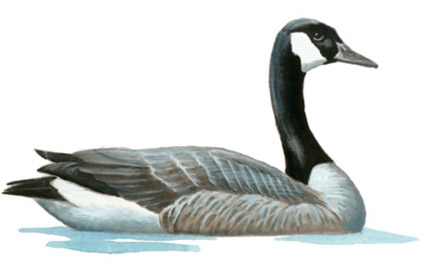

Family Anatidae (Geese, Ducks, and Mergansers)
Size: 27–35" depending on race
Range: Throughout the United States
Habitat: Marshes, grasslands, public parks, golf courses
The Canada Goose is the most common goose in the United States and is found in suburban settings. It is vegetarian, foraging on land for grass, seeds, and grain or in the water by upending like the dabbling ducks. It has a heavy body with short, thick legs and a long neck. Overall its coloring is barred gray brown, with a white rear, a short black tail, a black neck, and a white patch running from under the neck to behind the eye. During its powerful flight, the goose’s white rump makes a semicircular patch between the tail and back. Its voice is a loud honk. In flight Canada Geese form the classic V formation. The adult is illustrated.
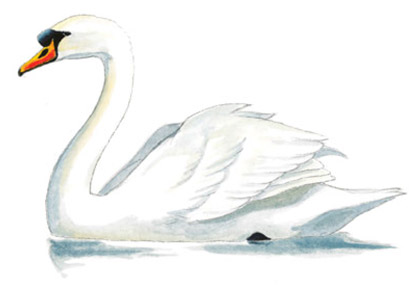
Family Anatidae (Geese, Ducks, Mergansers)
Size: 60"
Range: Northeastern United States
Habitat: Ponds, lakes, coastal bays; usually in or near developed areas
Native to northern Europe and central Asia, the Mute Swan was introduced in the early 1900s to parks and gardens of the eastern United States. It is a large, graceful swan that holds its neck in a smooth curve and has a relatively long pointed tail and uniformly white plumage. The face is black in front of the eyes, meeting with a reddish orange bill and a black, bulbous knob at the forehead. Although mostly quiet, it is capable of a range of hisses, snorts, and loud nasal calls. Mute Swans forage for aquatic plants and can be quite aggressive, often displaying a posture with the head tilted down and the wings raised over the back. It is a species of concern, because as its range expands it displaces many native birds. The adult is illustrated.
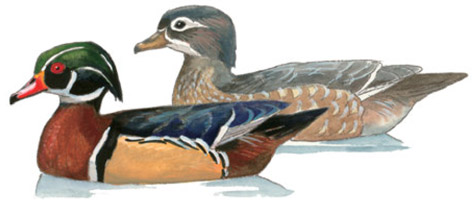
Family Anatidae (Geese, Ducks, Mergansers)
Size: 18"
Range: Most of the contiguous United States except for the southwestern region
Habitat: Wooded ponds and swamps
The regal Wood Duck is among the dabbling ducks, or those that tip headfirst into shallow water to pluck aquatic plants and animals from the bottom. The male is long tailed and small billed and shows a dark back, light buff flanks, and sharp black-and-white head patterning. It also sports a bushy head crest that droops behind the nape. The female is gray brown with spotting along the underside and a conspicuous white teardrop-shaped eye patch. Both sexes swim with their heads angled downward as if in a nod and have sharp claws, which they use to cling to branches and snags. The breeding female (top) and breeding male are illustrated.
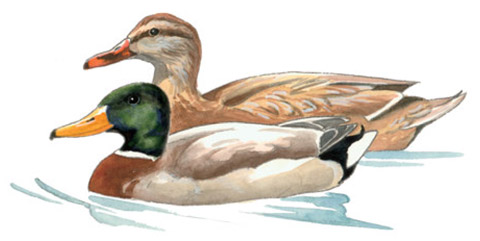
Family Anatidae (Geese, Ducks, and Mergansers)
Size: 23"
Range: Throughout the United States
Habitat: Parks and urban areas; virtually any environment with water
The ubiquitous Mallard is the most abundant duck in the Northern Hemisphere. It is a classic dabbling duck, plunging its head into the water with its tail up, searching for aquatic plants, animals, and snails. It will also eat worms, seeds, insects, and even mice. Noisy and quacking, it is heavy but a strong flier. The male has a dark head with green or blue iridescence, a white neck ring, and a large yellow bill. His underparts are pale, with a chestnut-brown breast. The female is plain brownish, with buff-colored, scalloped markings. She also has a dark eye line and an orangey bill with a dark center. The speculum is blue on both sexes, and the tail coverts often curl upward. Mallards form huge floating flocks called “rafts.” To achieve flight, the mallard lifts straight into the air without running. The breeding male, below, and a female, above, are illustrated.
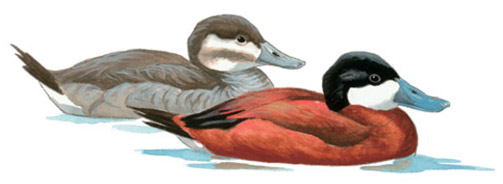
Family Anatidae (Geese, Ducks, and Mergansers)
Size: 15"
Range: Throughout the United States
Habitat: Open water, wetlands
The Ruddy Duck is a “stiff-tailed duck,” part of a group known for rigid tail feathers that are often cocked up in display. It dives deep for its food, which consists of aquatic vegetation, and flies low over the water with quick wing beats. A relatively small duck, with a big head and a flat, broad body, the breeding male is a rich sienna brown overall, with white cheeks, a black cap and nape, and a bright blue bill. The female is drab, with a conspicuous dark stripe across her cheek. Nonbreeding males become gray. The Ruddy Duck can sink low into the water, grebe-like, and will often dive to escape danger. The breeding male, below, and a female, above, are illustrated.
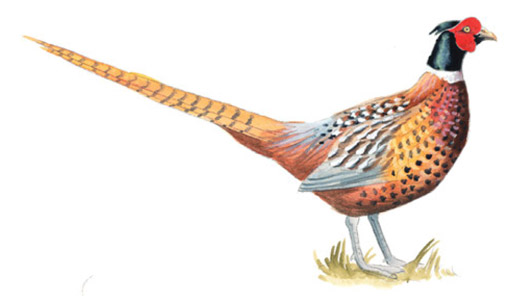
Family Phasianidae (Pheasants, Grouse, and Turkeys)
Size: 21" (male), 34" (female)
Range: Mostly higher latitudes across the United States, south to Texas
Habitat: Grasslands, woodland edges, agricultural land with brushy cover
The Ring-necked Pheasant is a large chicken-shaped bird with a long pointed tail. The male is ornately patterned in rufous tones, gold, and blue gray, with pale spotting on the wings and back and dark spotting underneath. His head is an iridescent green-blue with a tufted crown; he has red facial skin and a white ring about the neck. The female is mottled brown above and plain below, without obvious head markings. Ring-necked Pheasants peck on the ground for seeds, grasses, and insects. Their vocalizations include a harsh auk caw, and they produce muffled wing fluttering. The adult male is illustrated.
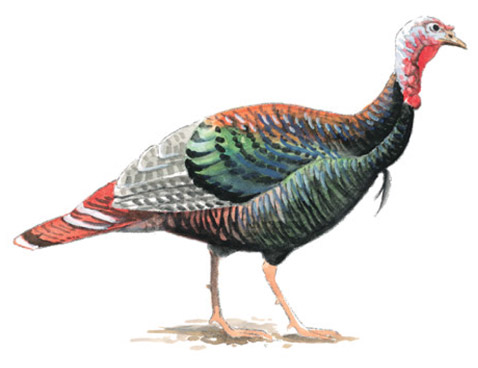
Family Phasianidae (Pheasants, Grouse, and Turkeys)
Size: 36–48"; males larger than females
Range: Throughout most of the contiguous United States
Habitat: Open mixed woodlands
The Wild Turkey is a very large, dark, ground-dwelling bird (but is slimmer than the domestic turkey). The head and neck appear small for the body size, and the legs are thick and stout. The heavily barred plumage is quite iridescent in strong light. The turkey’s head and neck are covered with bluish, warty, crinkled bare skin that droops under the chin in a red wattle. Often foraging in flocks, Wild Turkeys search the ground for seeds, grubs, and insects, then roost at night in trees. Males emit the familiar gobble, while females are less vocal, making a soft clucking sound. In display the male hunches with his tail up and spread like a giant fan. The adult male is illustrated.
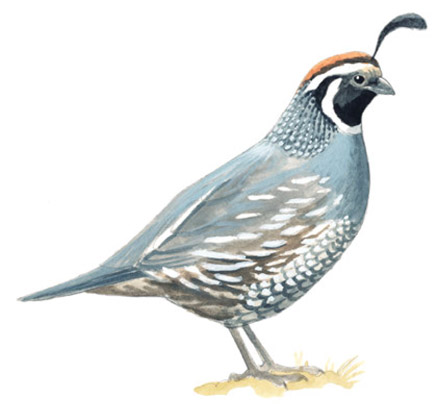
Family Odontophoridae (Quail)
Size: 10"
Range: Pacific states, inland to Utah
Habitat: Open woodlands, shrubby areas, rural gardens
The California state bird, this is an elegant, gentle, little ground bird with a curious, forward-projecting head plume and a short curved bill. The male is grayish overall, with pale barring and scaling on the sides, flanks, and belly. The head is boldly marked with a rusty crown, black face, and white stripes above the eyes and around the chin. The female lacks the bold head pattern, and the plume is much smaller. California Quail travel in groups, picking the ground for seeds, insects, and berries. Their voice is a squawking, throaty, usually three-noted caw-CAW-caw, sometimes dubbed chi-CA-go. They roost low in trees or brush. The adult male is illustrated.
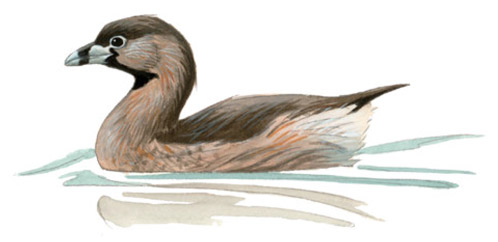
Family Podicipedidae (Grebes)
Size: 13"
Range: Throughout the contiguous United States
Habitat: Freshwater ponds and lakes
The Pied-billed Grebe is small and secretive. It lurks in sheltered waters, diving for small fish, leeches, snails, and crawfish. When alarmed, or to avoid predatory snakes and hawks, it sinks below the surface until only its head is above water. It is brownish overall but slightly darker above, with a tiny tail and short wings. Breeding adults have a conspicuous dark ring around the middle of the bill. The ring is missing in winter plumage. The grebe nests on a floating mat of vegetation. The breeding adult is illustrated.
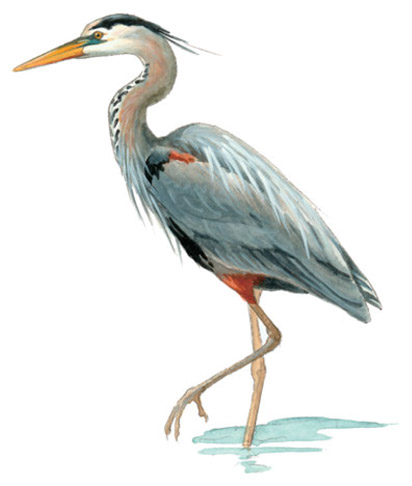
Family Ardeidae (Herons and Egrets)
Size: 46"
Range: Throughout the contiguous United States
Habitat: Most aquatic areas, including lakes, creeks, and marshes
The Great Blue Heron is the largest heron in North America. Walking slowly through shallow water or fields, it stalks fish, crabs, and small vertebrates, catching them with its massive bill. With long legs and a long neck, the heron is blue-gray overall, with a white face and a heavy yellow-orange bill. Its crown is black and supports plumes of medium length. The front of the neck is white, with distinct black chevrons fading into breast plumes. In flight the neck is tucked back, and the heron’s wing beats are regular and labored. The adult is illustrated.
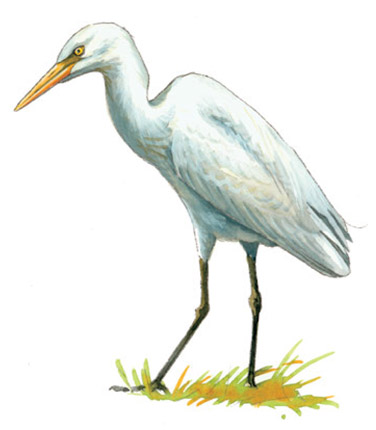
Family Ardeidae (Herons and Egrets)
Size: 20"
Range: Scattered regions throughout the United States, mostly in lower latitudes
Habitat: Upland fields, often near cattle in grazing land
The Cattle Egret is a widespread species originally from Africa and now quite common throughout much of North America. Unlike most herons, it is not normally found in aquatic environments. It forms groups around cattle, often perching atop them, and feeds on insects aroused by the movement of their hooves. It is stocky and all white with a comparatively short yellow bill and short black legs. In breeding plumage, the legs and bill turn a bright orange, and a peachy pale yellow forms on the crown, breast, and back. The illustration shows a nonbreeding adult.
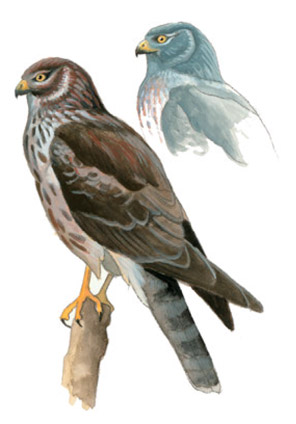
Family Accipitridae (Hawks and Eagles)
Size: 18"; females larger than males
Range: Throughout North America
Habitat: Open fields, wetlands
Also known as the Marsh Hawk, the Northern Harrier flies low over the landscape, methodically surveying its hunting grounds for rodents and other small animals. When it spots prey, aided by its acute hearing, it drops abruptly to the ground to attack. The Northern Harrier is a thin raptor with a long tail and long, flame-shaped wings that are broad in the middle. The face has a distinct owl-like facial disk, and there is a conspicuous white patch at the rump. Males are gray above, with a white, streaked breast and black wing tips. Females are brown with a barred breast. The juvenile is similar in plumage to the female, but with a pale belly. The female, below, and a male, above, are illustrated.
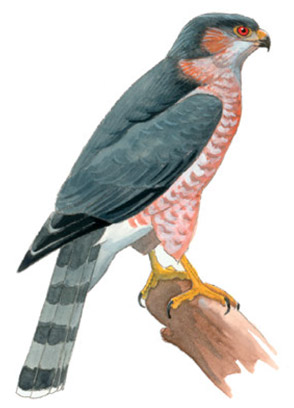
Family Accipitridae (Hawks and Eagles)
Size: 10–14"; females larger than males
Range: Throughout North America
Habitat: Woodlands, bushy areas, yards
The Sharp-shinned Hawk is North America’s smallest accipiter, with a longish squared tail and stubby rounded wings. Its short wings allow for agile flight in tight, wooded quarters, where it quickly attacks small birds in flight. It is grayish above and light below, barred with pale rufous stripes. The eyes are set forward on the face to aid in the direct pursuit of prey. The juvenile is white below, streaked with brown. The Sharp-shinned Hawk may be confused with the larger Cooper’s Hawk. The adult is illustrated.
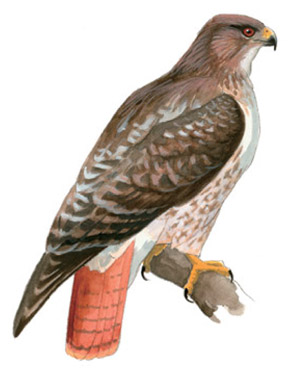
Family Accipitridae (Hawks and Eagles)
Size: 20"
Range: Throughout North America
Habitat: Prairies, open country
This widespread species is the most common buteo (broad-winged hawks of the genus Buteo) in the United States. It has broad rounded wings and a stout hooked bill. Its plumage is highly variable depending on its geographic location. In general the underparts are light, with darker streaking that forms a dark band across the belly; the upperparts are dark brown; and the tail is rufous. Light spotting occurs along the scapulars. In flight there is a noticeable dark patch along the inner leading edge of the underwing. Red-tailed Hawks glide down from perches, such as telephone poles and posts in open country, to catch rodents. They also may hover to spot prey. They are usually seen alone or in pairs. The voice is the familiar keeer! The adult is illustrated.
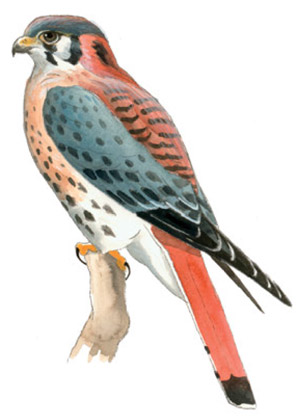
Family Falconidae (Falcons)
Size: 10"
Range: Throughout North America
Habitat: Open areas, roadsides, fences and telephone wires
North America’s most common falcon, the American Kestrel is tiny (about the size of a robin), with long pointed wings and tail, and fast flight. It hovers above fields or dives from a perch in branches or on a wire to capture small animals and insects. The kestrel’s upperparts are rufous and barred with black, its wings are blue gray, and its breast is buff or white and streaked with black spots. The head is patterned with a gray crown and vertical patches of black down the face. The female has rufous wings and a barred tail. Also known as the Sparrow Hawk, the Kestrel has a habit of flicking its tail up and down while perched. The adult male is illustrated.
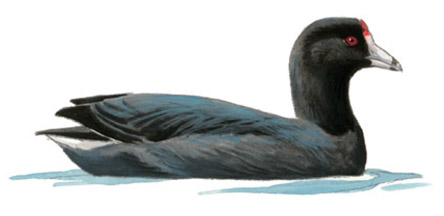
Family Rallidae (Rails and Coots)
Size: 15"
Range: Throughout North America
Habitat: Wetlands, ponds, urban lawns and parks
The American Coot has a plump body and thick head and neck. A relatively tame bird, it is commonly seen in urban areas and parks. It dives for fish to feed, but it will also dabble like a duck or pick food from the ground. It is dark gray overall, with a black head and white bill that ends with a dark, narrow ring. The white trailing edge of the wings can be seen in flight. The toes are flanked with lobes that enable the coot to walk on water plants and swim efficiently. Juveniles are similar in plumage to adults but paler. Coots are often seen in very large flocks. The adult is illustrated.
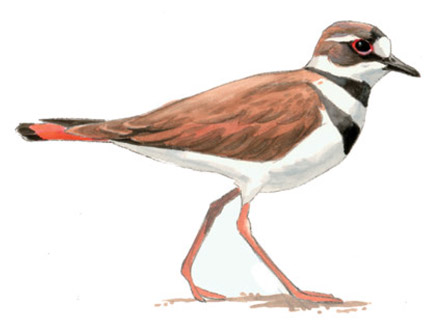
Family Charadriidae (Plovers)
Size: 10"
Range: Throughout North America
Habitat: Fields, farmlands, lakeshores, meadows
The Killdeer gets its name from its piercing kill-dee call, which is often heard before these well-camouflaged plovers are seen. Well adapted to human-altered environments, the killdeer is quite widespread and gregarious. It has long pointed wings, a long tail, and a conspicuous double-banded breast. Its upper parts are dark brown, its belly is white, and its head is patterned with a white supercilium and forehead. The tail is rusty orange with a black tip. In flight a noticeable white stripe can be seen across the flight feathers. The Killdeer is known for its classic “broken wing” display, which it uses to distract predators from its nest and young. The adult is illustrated.
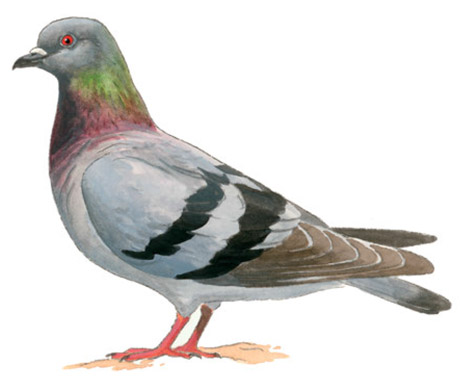
Family Columbidae (Pigeons and Doves)
Size: 12"
Range: Throughout the contiguous United States
Habitat: Urban areas, farmland
Formerly known as the Rock Dove, the Rock Pigeon is the common pigeon seen in almost every urban area across the continent. Introduced from Europe, where it inhabits rocky cliffs, Rock Pigeons have adapted to city life, and domestication has resulted in a wide variety of plumage colors and patterns. The original, wild version is a stocky gray bird with a darker head and neck and green to purple iridescence along the sides of the neck. The eyes are bright red, and the bill has a fleshy white protuberance (cere) on the base of the upper mandible. There are two dark bars across the back when the wing is folded, the rump is white, and the tail has a dark terminal band. Variants range from white to brown to black, with many pattern combinations. The adult is illustrated.
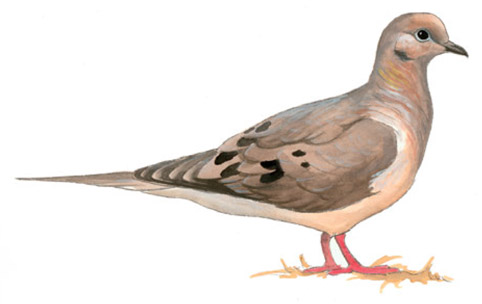
Family Columbidae (Pigeons and Doves)
Size: 12"
Range: Throughout the contiguous United States
Habitat: Open brushy areas, urban areas
The common Mourning Dove is a sleek, long-tailed dove with a thin neck, a small rounded head, and large black eyes. It is pale gray brown underneath and darker above, with some iridescence to the feathers on the neck. There are clear black spots on the tertials and some coverts and a dark spot on the upper neck below the eye. The pointed tail is edged with a white band. The Mourning Dove pecks on the ground for seeds and grains and walks with quick, short steps while bobbing its head. Its flight is strong and direct, and the wings create a whistle as the bird takes off. Its voice is a mournful, owl-like cooing. It is solitary or found in small groups but may form large flocks where food is abundant. The adult is illustrated.
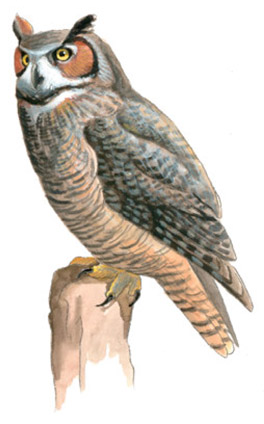
Family Strigidae (Typical Owls)
Size: 22"
Range: Throughout North America
Habitat: Almost any environment, including forests, plains, and urban areas
Found throughout North America, the Great Horned Owl is large and strong, with an obvious facial disk and sharp, long talons. Plumage is variable: Eastern forms are brown overall with heavy barring, a rust-colored face, and a white chin patch, while western forms are grayer. The prominent ear tufts give the owl its name, and its eyes are large and yellow. The Great Horned Owl has exceptional hearing and sight. It feeds at night, perching on branches or posts and then swooping down on silent wings to catch birds, snakes, or mammals up to the size of a house cat. Its voice is a low hoo-hoo-hoo. The adult is illustrated.
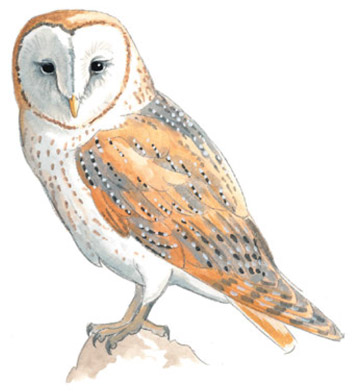
Family Tytonidae (Barn Owl)
Size: 23"
Range: Throughout most of the contiguous United States except for the northern Midwest regions
Habitat: Barns, farmland, open areas with mature trees
The Barn Owl is a large-headed pale owl with small dark eyes, a heart-shaped facial disk, and long feathered legs. The wings, back, tail, and crown are light rusty brown with light gray smudging and small white dots. The underside, face, and underwing linings are white, with spots of rust on the breast. Females are usually darker than males, with more color and spotting across the breast and sides. The facial disk is enclosed by a thin line of dark feathers. The Barn Owl is a nocturnal hunter for rodents, and its call is a haunting, raspy screeee! The adult male is illustrated.
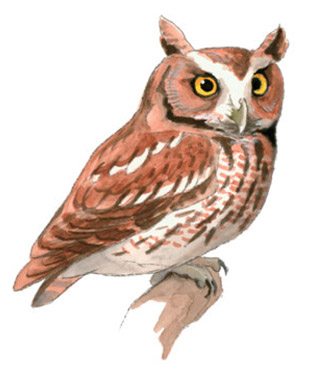
Family Strigidae (Typical Owls)
Size: 8½"
Range: Central and eastern United States
Habitat: Wooded areas or parks, places where cavity-bearing trees exist
The Eastern Screech-Owl is a small, big-headed, eared owl with a short tail and bright yellow eyes. The highly camouflaged plumage ranges from reddish to brown to gray, depending on the region, but the red form is most common in the East. It is darker above, streaked and barred below. The ear tufts may be drawn back to give a rounded head appearance, and the bill is grayish green tipped with white. White spots on the margins of the coverts and scapulars create two white bars on the folded wing. The Eastern Screech-Owl is a nocturnal bird, hunting during the night for small mammals, insects, or fish. Its voice is a descending, whistling call or a rapid staccato of one pitch. The illustration shows a red morph adult. The similar Western Screech-Owl is found west of the Continental Divide.
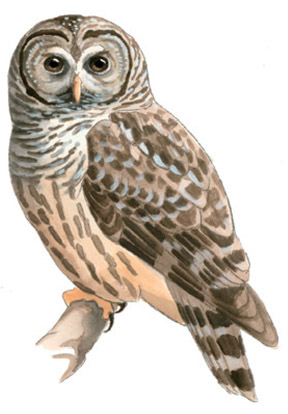
Family Strigidae (Typical Owls)
Size: 21"
Range: Eastern half of the United States, Pacific Northwest
Habitat: Wooded swamps, upland forests
The Barred Owl is a large, compact owl with a short tail and wings, rounded head, and big dark eyes. It lacks the ear tufts seen on the Great Horned Owl and has comparatively small talons. Its plumage is gray brown overall, with dark barring on the neck and breast, turning to streaking on the belly and flanks. It swoops from its perch to catch small rodents, frogs, or snakes. Its voice, often heard during the day, is a hooting who-cooks-for-you or a kind of bark. It nests in tree cavities vacated by other species. The illustration shows an adult.
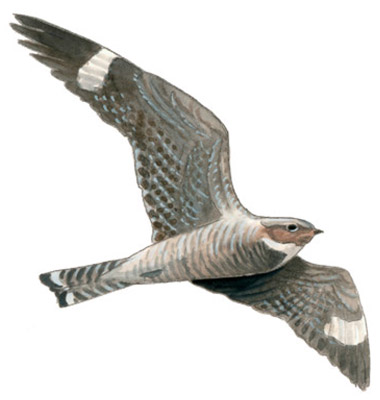
Family Caprimulgidae (Nightjars and Nighthawks)
Size: 9"
Range: Throughout North America
Habitat: Variety of habitats: forests, marshes, plains, urban areas
The Common Nighthawk is primarily nocturnal but may often be seen flying during the day and evening hours, catching insects on the wing with bounding flight. It is cryptically mottled gray, brown, and black, with strong barring on an otherwise pale underside. A white breast band is evident in the male. The tail is long and slightly notched, and the wings are long and pointed, extending past the tail in the perched bird. In flight there is a distinct white patch on both sides of the wings. During the day the Common Nighthawk is usually seen roosting on posts or branches with its eyes closed. Its voice is a short, nasal buzzing sound. The adult male is illustrated.
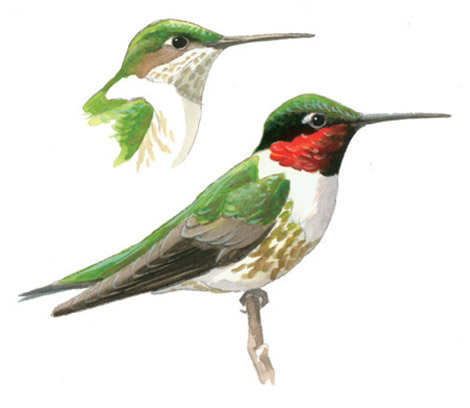
Family Trochilidae (Hummingbirds)
Size: 3½"
Range: Eastern half of the United States
Habitat: Areas with flowering plants, gardens, urban feeders
The Ruby-throated Hummingbird is a small, delicate bird able to hover on wings that beat at a blinding speed. It uses its long, needle-like bill to probe deep into flowers and lap up the nectar. Its feet are tiny and its body is white below and green above. Males have a dark green crown and iridescent red throat, or gorget. Females lack the colored gorget and have a light green crown and white-tipped tail feathers. Their behavior is typical of hummingbirds, hovering and buzzing from flower to flower, emitting chits and squeaks. Most of these birds migrate across the Gulf of Mexico to South America in the winter. The illustration shows an adult male (bottom) and female (top).
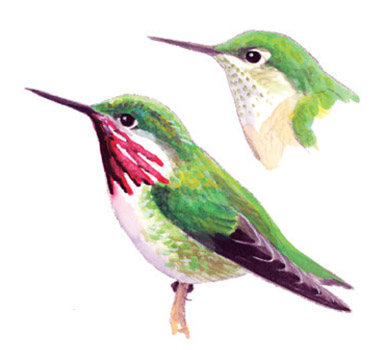
Family Trochilidae (Hummingbirds)
Size: 3¼"
Range: West of the Continental Divide
Habitat: Brushy fields, feeders
The smallest breeding bird in North America, and an uncommon visitor to New England, the Calliope Hummingbird is a tiny, short-tailed and short-billed hummingbird with wings that extend beyond the tail when perched. The adult male is iridescent green above, on the head, and along the sides, while below it is white with an iridescent red, streaked gorget (sometimes held stiffly away from the body). Females are green above and buff below, with sparse, dark streaking on the throat. Although a tiny bird, the Calliope Hummingbird makes an arduous migration to wintering grounds in Mexico each year. It feeds on flower nectar or feeders from a hover or hunts small insects mid-air. Its voice is a quick, high-pitched zip and buzzy chatterings. The female (top) and male are illustrated.
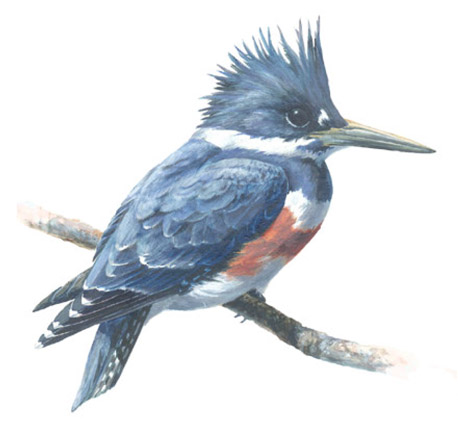
Family Alcedinidae (Kingfishers)
Size: 13"
Range: Throughout North America
Habitat: Creeks, lakes
The widespread but solitary Belted Kingfisher is stocky and has a large head with a long, powerful bill and a shaggy crest. It is grayish blue-green above and white below, with a thick blue band across its breast and white dotting on its back. White spots are at the lores. The female has an extra breast band of rufous hue, and is rufous along the flanks. Belted Kingfishers feed by springing from a perch along the water’s edge or hovering above the water, then plunging headfirst to snatch fish, frogs, or tadpoles. Flight is uneven, and the kingfisher’s vocalization is a raspy, rattling sound. The adult female is illustrated.
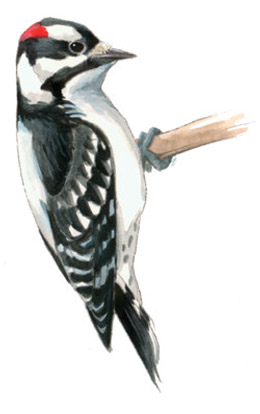
Family Picidae (Woodpeckers)
Size: 6½"
Range: Throughout North America
Habitat: Woodlands, parks, urban areas, streamsides
The Downy Woodpecker is tiny, with a small bill and a relatively large head. It is white underneath with no barring and has black wings barred with white and a patch of white on its back. Its head is boldly patterned in white and black, and the male sports a red nape patch. The base of the bill joins the head with fluffy nasal tufts. Juveniles may show some red on the forehead and crown. The Downy Woodpecker forages for berries and insects in the bark and among the smaller twigs of trees. The very similar Hairy Woodpecker is larger, with a longer bill and more aggressive foraging behavior, sticking to larger branches and not clinging to twigs. The adult male is illustrated.
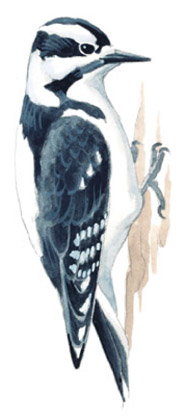
Family Picidae (Woodpeckers)
Size: 9"
Range: Throughout North America
Habitat: Mixed woodlands, streamsides near large trees
The Hairy Woodpecker is very similar in plumage to the Downy Woodpecker but is larger and has a heavier bill. Also, it pecks for insects in tree bark or on larger branches and will not feed from smaller twigs, as does the Downy. It is mostly black above with a white patch on the back and outer tail feathers and some white spotting on the wings. The underside is white with no barring. The head is patterned black and white, and there are small nasal tufts. Males show a red patch on the back of the crown. Voice includes a high-pitched, squeaky chip-chip, as well as loud drumming. The adult female is illustrated.
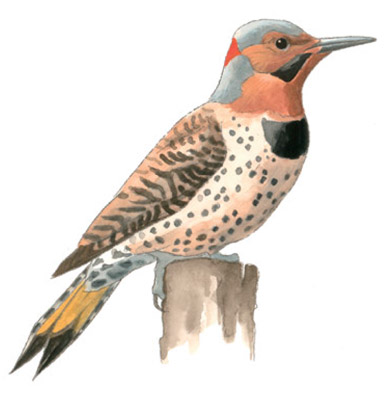
Family Picidae (Woodpeckers)
Size: 12½"
Range: Throughout North America
Habitat: Variety of habitats including suburbs and parks
The common Northern Flicker is a large, long-tailed woodpecker often seen foraging on the ground for ants and other small insects. It is barred brown-and-black across the back, and is buff with black spotting below. Its head is brown, with a gray nape and crown. On the upper breast is a prominent half-circle of black, and the male has a red or black patch at the malar region (Eastern forms have a black malar area). Flight is undulating and shows an orange wing lining and white rump. The flicker’s voice is a loud, sharp keee, and it will sometimes drum its bill repeatedly at objects, like a jackhammer. It is sometimes referred to as the red-shafted or yellow-shafted flicker. The adult Eastern race male is illustrated.
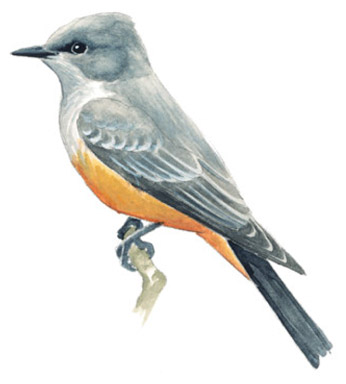
Family Tyrannidae (Tyrant Flycatchers)
Size: 7½"
Range: Western and central United States
Habitat: Arid open country, shrub land
The Say’s Phoebe is a fairly slim flycatcher with a long black tail. It is pale gray brown above, with lighter wings bars. The underside is whitish to gray under the chin and breast, fading to orange-brown on the belly and undertail coverts. Its head has a flat crown that often peaks toward the rear, and the bird has dark eyes, lores, and bill. It fly-catches for insects from a perch on rocks or twigs. The Say’s Phoebe voices a high, whistled pit-eur, and often pumps or flares out its tail. The adult is illustrated.
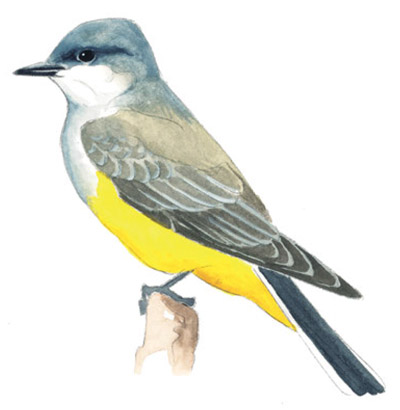
Family Tyrannidae (Tyrant Flycatchers)
Size: 8¾"
Range: Mostly in central and western United States, but found farther east as well
Habitat: Open fields, agricultural areas
The Western Kingbird is a relatively slender flycatcher, with a stout black bill and a slightly rounded, black tail with white along the outer edge. It is grayish or greenish-brown above, pale gray on the breast, and bright yellow on the belly, sides, and undertail coverts. The head is light gray, with a white throat and malar area, and dark gray at the lores and behind the eye. It has a small, reddish crown patch that is normally concealed. Western Kingbirds fly-catch for insects from perches on branches, posts, or wires, and the voice is composed of quick, high-pitched zips and chits. The adult is illustrated.
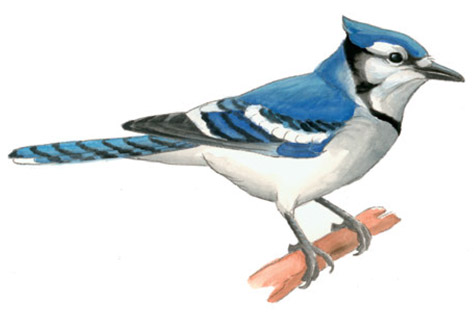
Family Corvidae (Jays, Magpies, and Crows)
Size: 11"
Range: East of the Continental Divide
Habitat: Woodlands, rural and urban areas
The solitary Blue Jay is sturdy and crested. It is bright blue above and white below, with a thick, tapered black bill. There is a white patch around the eye that extends to the chin, bordered by a thin, black “necklace” extending to the nape. The blue jay has a conspicuous white wing bar and dark barring on the wings and tail. In flight the white outer edges of the tail are visible. The jay alternates shallow wing beats with glides. Omnivorous, the Blue Jay eats just about anything, but especially consumes acorns, nuts, fruits, insects, and small vertebrates. It is a raucous and noisy bird, and quite bold. Sometimes it mimics the calls of birds of prey. The adult is illustrated.
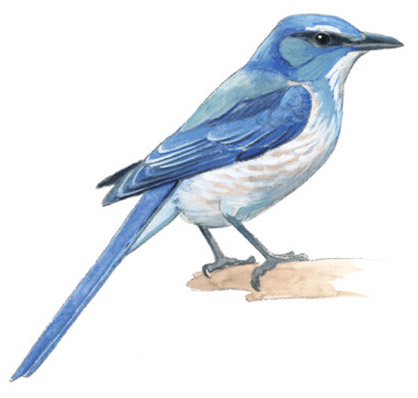
Family Corvidae (Jays, Magpies, and Crows)
Size: 11½"
Range: Western United States
Habitat: Open areas of scrub oak, urban areas
The Western Scrub Jay is long-necked, sleek, and crestless. Its upperparts are deep blue, with a distinct, lighter gray-brown mantle. Its underparts are pale gray, becoming white on the belly and undertail coverts. It has a thin white superciliary stripe, the malar area is dark gray, and the throat is streaked with white and gray above a dull gray “necklace” across the breast. The bird’s flight is an undulating combination of rapid wing beats and swooping glides. Its diet consists of nuts, seeds, insects, and fruit. The adult is illustrated.
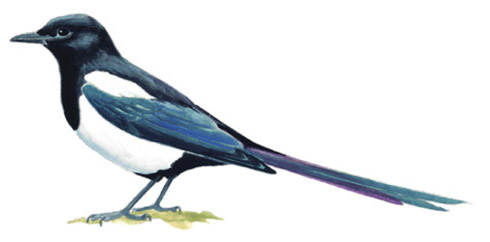
Family Corvidae (Jays, Magpies, and Crows)
Size: 19"
Range: Western United States up to Alaska
Habitat: Riparian areas, open woodlands, pastures, rural areas
The Black-billed Magpie is heavy, with broad wings and an extremely long, graduated tail. It has striking pied plumage: black on the head, upper breast, and back; dark, iridescent green-blue on the wings and tail; and crisp white on the scapulars and belly. Its legs are dark and stout, and its bill is thick at the base. Juvenile birds have a much shorter tail. Magpies travel in small groups and are opportunistic feeders, eating insects, nuts, eggs, or carrion. The voice is a whining, questioning mag? or a harsh wok-wok. The adult is illustrated.
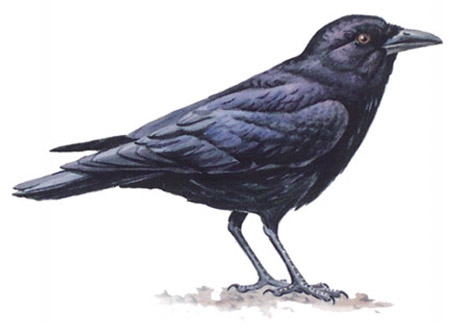
Family Corvidae (Jays, Magpies, and Crows)
Size: 17½"
Range: Throughout the contiguous United States
Habitat: Open woodlands, pastures, rural fields, dumps
The American Crow is widespread, found across the continent. Known for its familiar, loud, grating caw, caw vocalization, the crow is a large, stocky bird with a short rounded tail, broad wings, and a thick, powerful bill. Plumage is glistening black overall in all stages of development. It will eat almost anything and often forms loose flocks with other crows. The adult is illustrated.
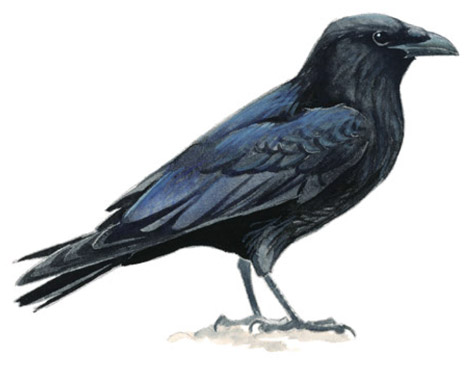
Family Corvidae (Jays, Magpies, and Crows)
Size: 24"
Range: Western and northern United States to Alaska, including the Appalachian Mountains
Habitat: Wide range of habitats, including deserts, mountains, canyons, forests
The Common Raven is a large, stocky, gruff corvid with a long, massive bill that slopes directly into the forehead. The wings are narrow and long, and the tail is rounded or wedge shaped. The entire body is glossy black, sometimes bluish, and the neck is laced with pointed, shaggy feathers. Quite omnivorous, the Common Raven feeds on carrion, refuse, insects, and roadkill. It has a varied voice that includes deep croaking. Ravens may soar and engage in rather acrobatic flight. Crows are similar but are smaller, with proportionately smaller bills. The adult is illustrated.
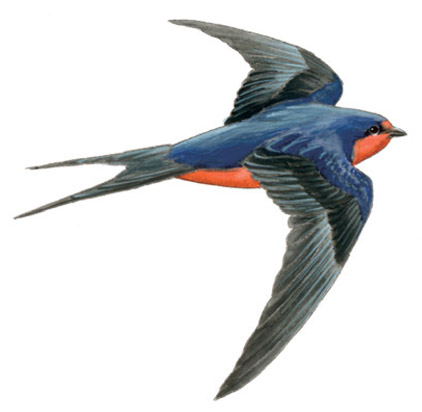
Family Hirundinidae (Swallows)
Size: 6½"
Range: Throughout the contiguous United States
Habitat: Old buildings, caves, open rural areas near bridges
Widespread and common, the Barn Swallow has narrow, pointed wings and a long, deeply forked tail. It is pale below and dark blue above, with a rusty orange forehead and throat. In males the underparts are pale orange, while females are a pale cream color below. Barn Swallows are graceful, fluid fliers, and they often forage in groups to catch insects in flight. The voice is a loud, repetitive chirping or clicking. They build cup-shaped nests of mud on almost any protected man-made structure. The adult male is illustrated.
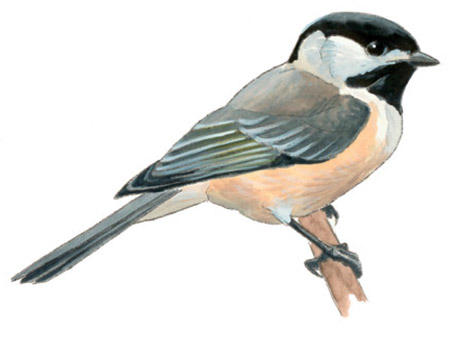
Family Paridae (Chickadees and Titmice)
Size: 5¼"
Range: Northern latitudes across the United States, Alaska
Habitat: Mixed woodlands, rural gardens, feeders
The Black-capped Chickadee is small, compact, and active, with short, rounded wings and a tiny black bill. It is gray above and lighter gray or dusky below, with a contrasting black cap and throat patch. It is quite similar to the Eastern Carolina Chickadee, which occurs in the Southeast. Its voice sounds like its name— chick-a-dee-dee-dee—or is a soft fee-bay. The chickadee is quite social and feeds on a variety of seeds, berries, and insects found in trees and shrubs. The adult is illustrated.
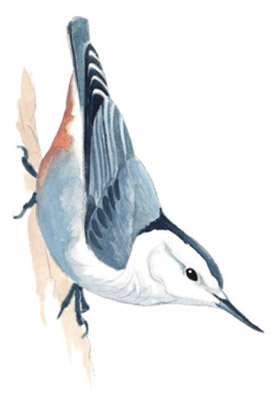
Family Sittidae (Nuthatches)
Size: 5¾"
Range: Throughout the contiguous United States
Habitat: Mixed oak or coniferous woodlands
The White-breasted Nuthatch has a large head; a wide neck; short, rounded wings; and a short tail. It is blue gray above and pale gray below, with rusty smudging on the lower flanks and undertail coverts. The breast and face are white, and a black crown merges with the mantle. The bill is long, thin, and upturned at the tip. To forage, the White-breasted Nuthatch creeps headfirst down tree trunks to pick out insects and seeds. Its voice is a nasal, repetitive auk, auk, auk. It nests in tree cavities high off the ground. The adult male is illustrated.
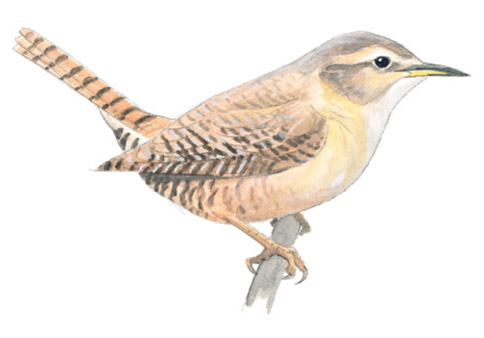
Family Troglodytidae (Wrens)
Size: 4¾"
Range: Throughout the contiguous United States
Habitat: Shrubby areas, rural gardens
The House Wren is a loud, drab wren with short, rounded wings and a thin, pointed, downcurved bill. Plumage is brown and barred above and pale gray brown below, with barring on the lower belly, undertail coverts, and tail. The head is lighter on the throat, at the lores, and above the eyes. House Wrens feed in the brush for insects and sing rapid, melodic, chirping songs, often while cocking their tails downward. The adult is illustrated.
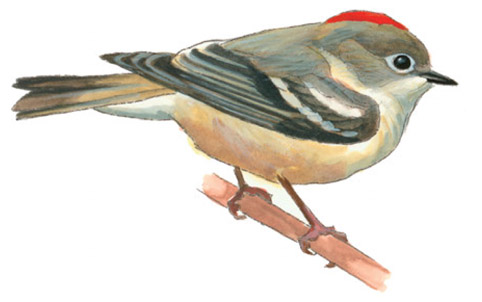
Family Regulidae (Kinglets)
Size: 4"
Range: Throughout North America
Habitat: Shrubs and leafy trees
The Ruby-crowned Kinglet is a tiny, plump songbird with a short tail and a diminutive, thin bill. It has a habit of nervously twitching its wings as it actively flits through vegetation, gleaning small insects and larvae. It may also hover in search of food. Plumage is pale olive green above and paler below, with patterned wings and pale wing bars on the upper coverts. There are white eye rings or crescents around the eyes. The bright red crest of the male bird is faintly noticeable unless the crest is raised. Its voice is a very high-pitched whistling seeee. The adult is illustrated.
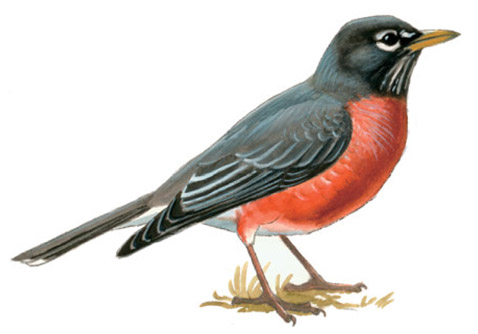
Family Turdidae (Thrushes)
Size: 10"
Range: Throughout North America
Habitat: Widespread in a variety of habitats, including woodlands, fields, parks, lawns
Familiar and friendly, the American Robin is a large thrush with long legs and a long tail. It commonly holds its head cocked and keeps its wing tips lowered beneath its tail. It is gray brown above and rufous below, with a darker head and contrasting white eye crescents and loral patches. The chin is streaked black and white, and the bill is yellow with darker edges. Females are typically paler overall, and the juvenile shows spots of white above and dark spots below. Robins forage on the ground for earthworms and insects and in trees for berries. The robin’s song is a series of high, musical phrases, sounding like cheery, cheer-u-up, cheerio. The adult male is illustrated.
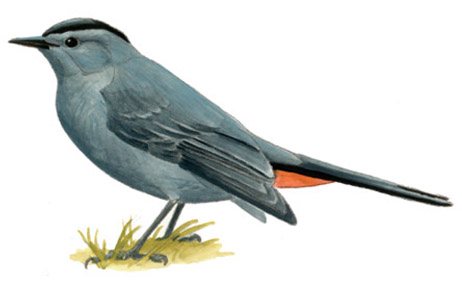
Family Mimidae (Mockingbirds, Catbirds, and Thrashers)
Size: 8½"
Range: Throughout the contiguous United States; less common in the far West
Habitat: Understory of woodland edges, shrubs, rural gardens
The solitary Gray Catbird is sleek and has a long neck and sturdy pointed bill. It is uniformly gray except for its rufous undertail coverts, black crown, and black, rounded tail. It is quite secretive and spends most of its time hidden in thickets close to the ground, picking through the substrate for insects, berries, and seeds. Its call includes a nasal catlike meew, from which its name is derived, although it will also mimic the songs of other birds. To escape danger, the Gray Catbird will often choose to run away rather than fly. The adult is illustrated.
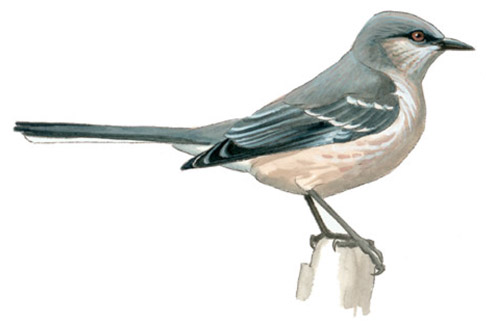
Family Mimidae (Mockingbirds, Catbirds, and Thrashers)
Size: 10½"
Range: Lower latitudes across the United States, up to New England
Habitat: Open fields, grassy areas near vegetative cover, suburbs, parks
The Northern Mockingbird is constantly vocalizing. Its scientific name, polyglottos, means “many voices,” alluding to its amazing mimicry of the songs of other birds. Sleek, long-tailed, and long-legged, it shows gray plumage above with darker wings and tail and off-white to brownish gray plumage below. The bird has two white wing bars; short, dark eye stripes; and pale eye rings. In flight, it reveals conspicuous white patches on the inner primaries and coverts and white outer tail feathers. Like other mimids, the mockingbird forages on the ground for insects and berries, intermittently flicking its wings. The adult is illustrated.
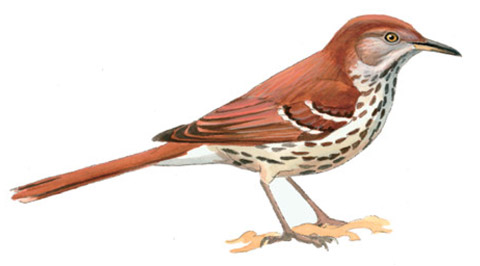
Family Mimidae (Mockingbirds, Catbirds, and Thrashers)
Size: 11"
Range: East of the Continental Divide
Habitat: Woodlands, thickets, urban gardens, orchards
The Brown Thrasher is primarily a ground-dwelling bird that thrashes through leaves and dirt for insects and plant material. It has a long tail and legs and a medium length, slightly decurved bill. Its plumage is rufous brown above, including the tail, and whitish below, and is heavily streaked with brown or black. There are two prominent, pale wing bars and pale outermost corners to the tail. Its eyes are yellow to orange. Its voice is a variety of musical phrases, often sung from a conspicuous perch. The illustration shows an adult.
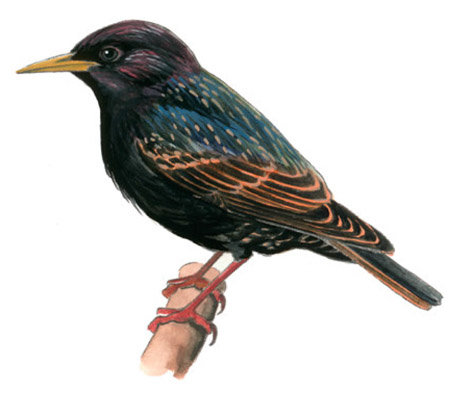
Family Sturnidae (Starlings)
Size: 8½"
Range: Throughout the contiguous United States
Habitat: Found almost anywhere, particularly in rural fields, gardens, dumps, urban parks
Introduced from Europe, the European Starling has successfully infiltrated most habitats in North America and competes with native birds for nest cavities. It is a stocky, sturdy, aggressive bird that is glossy black overall with a sheen of green or purple. The breeding adult has a yellow bill and greater iridescence, while the adult in winter is more flat black, with a black bill and numerous white spots. The tail is short and square. Starlings form very large, compact flocks and fly directly on pointed, triangular wings. Its diet is highly variable and includes insects, grains, and berries. Vocalizations include loud, wheezy whistles and clucks and imitations of other birdsongs. The breeding adult is illustrated.
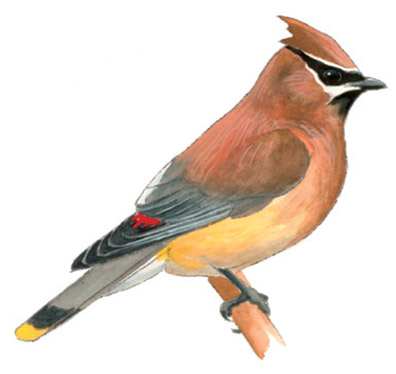
Family Bombycillidae (Waxwings)
Size: 7"
Range: Throughout the contiguous United States
Habitat: Woodlands, swamps, urban areas near berry trees
Quite similar to the Bohemian Waxwing, the Cedar Waxwing is a compact, crested songbird with pointed wings and a short tail. The sleek, smooth plumage is brownish gray overall with paler underparts, a yellowish wash on the belly, and white undertail coverts. The head pattern is striking, with a crisp black mask thinly bordered by white. The tail is tipped with bright yellow, and the tips of the secondary feathers are coated with a unique red, waxy substance. Cedar Waxwings will form large flocks and devour berries from a tree, then move on to the next. They may also catch small insects while in flight. Their voice is an extremely high-pitched, whistling seee. The adult is illustrated.
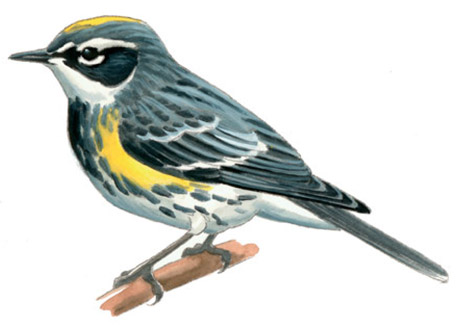
Family Parulidae (Wood Warblers)
Size: 5½"
Range: Throughout North America
Habitat: Deciduous and coniferous woodlands, suburbs with wax myrtle
Two races of this species occur in North America. The “myrtle” form is dispersed across North America, and the “Audubon’s” form is seen west of the Rockies. The myrtle variety is blue-gray above, with dark streaks, and white below, with black streaking below the chin and a bright yellow side patch. There is a black mask across the face, bordered by a thin superciliary stripe above and a white throat below. The nonbreeding adult males and females are paler, with a more brownish cast to the upperparts. The long-ish tail has white spots on either side and meets with the conspicuous yellow rump. The Audubon’s variety has a yellow chin and gray face. Yellow-rumped Warblers prefer to eat berries and insects. The adult male myrtle form is illustrated.
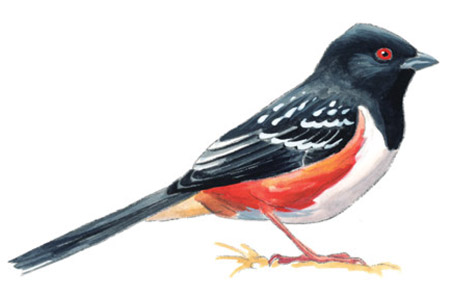
Family Emberizidae (Sparrows and Buntings)
Size: 8½"
Range: Western half of the United States
Habitat: Thickets, suburban shrubs, gardens
The Spotted Towhee is a large, long-tailed sparrow with a thick, short bill and sturdy legs. It forages on the ground in dense cover by kicking back both feet at once to uncover insects, seeds, and worms. It is black above, including the head and upper breast, and has rufous sides and a white belly. It has white wing bars, white spotting on its scapulars and mantle, and white corners on its tail. The eye color is red. Females are like the males, but are brown above. The Spotted Towhee was once conspecific with the Eastern Towhee, known as the rufous-sided towhee. The adult male is illustrated.
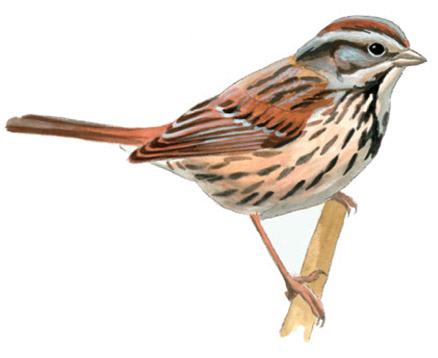
Family Emberizidae (Sparrows and Buntings)
Size: 6"
Range: Throughout North America
Habitat: Thickets, shrubs, woodland edges near water
One of the most common sparrows, the Song Sparrow is fairly plump, with a long, rounded tail. It is brown and gray with streaking above and white below, with heavy dark or brownish streaking that often congeals into a discreet spot in the middle of its breast. Its head has a dark crown with a gray medial stripe, dark eye lines, and a dark malar stripe above the white chin. Song Sparrows are usually seen in small groups or individually, foraging on the ground for insects and seeds. The song is a series of chips and trills of variable pitch, and the call is a chip, chip, chip. The adult is illustrated.
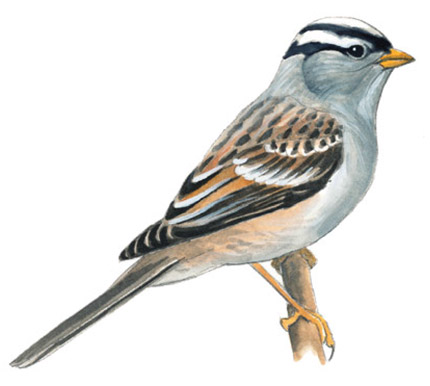
Family Emberizidae (Sparrows and Buntings)
Size: 7"
Range: Throughout North America
Habitat: Brushy areas, woodland edges, gardens
The White-crowned Sparrow has a rounded head, sometimes with a raised peak, and a fairly long, slightly notched tail. It is brownish above, streaked on the mantle, and shows pale wing bars. The underside is grayish on the breast, fading to pale brown on the belly and flanks. The head is gray below the eyes and boldly patterned black and white above the eyes, with a white medial crown stripe. The bill is bright yellow orange. White-crowned Sparrows forage on the ground, often in loose flocks, scratching for insects, seeds, and berries. Their song is variable, but it usually starts with one longer whistle, followed by several faster notes. The adult is illustrated.
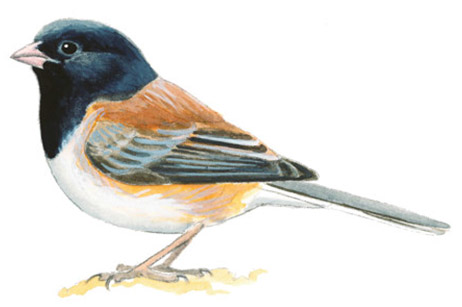
Family Emberizidae (Sparrows and Buntings)
Size: 6½"
Range: Throughout North America
Habitat: Thickets, rural gardens, open coniferous or mixed woodlands
The Dark-eyed Junco is a small, plump sparrow with a short, conical, pink bill and several distinct variations in plumage. One of the more common races is the “Oregon” junco, with its rusty brown mantle, sides, and flanks; white belly; and black head and breast. Sexes are similar, but the female is paler overall. The white outer tail feathers are obvious in flight. Juncos hop about on the ground, often in groups, picking up insects and seeds. The voice is a staccato, monotone chirping trill. Also common is the Gray-headed Junco, which is pale gray overall, with a rufous mantle. The adult male of the Oregon race is illustrated.
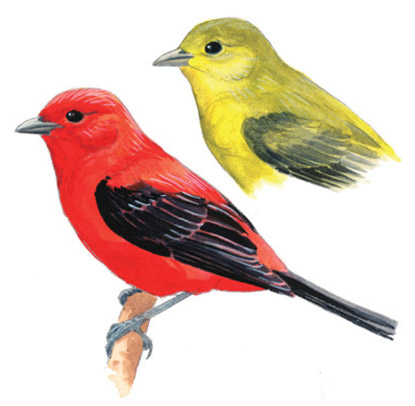
Family Cardinalidae (Cardinals, Grosbeaks, Tanagers, and Buntings)
Size: 7"
Range: Eastern half of the United States
Habitat: Leafy deciduous forests, suburban parks
The Scarlet Tanager is a secretive bird of the high canopy that is often detected first by its voice, despite its bright plumage. The breeding male is rich scarlet red overall, with contrasting black wings and tail. Females and nonbreeding males are similar, colored olive-yellow above and yellow below, with dark wings and tail. Males in fall molt show a patchwork of yellow, green, and red feathers. Scarlet Tanagers feed on insects, spiders, and berries at the upper levels of large trees, and they sing a series of raspy, quick phrases, comparable to that of a robin. The breeding (bottom) and nonbreeding (top) males are illustrated.
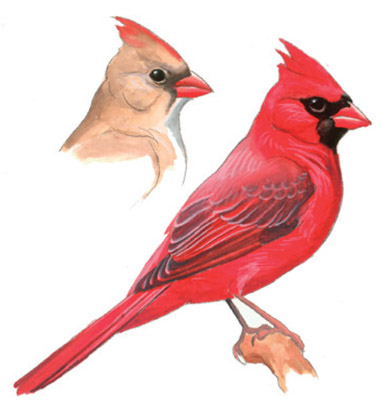
Family Cardinalidae (Cardinals, Grosbeaks, Tanagers, and Buntings)
Size: 8½"
Season: Eastern and central United States to Arizona
Habitat: Woodlands with thickets, suburban gardens
The Northern Cardinal with its thick, powerful bill eats mostly seeds but will also forage for fruit and insects. It is often found in pairs and is quite common at suburban feeders. It is a long-tailed songbird with a thick, short, orange bill and tall crest. The male is red overall with a black mask and chin. The female is brownish above, dusky below, and crested and has a dark front to its face. Juveniles are similar to the female but have a black bill. The voice is a musical weeta-weeta or woit heard from a tall, exposed perch. The illustration shows an adult male (bottom) and female (top).
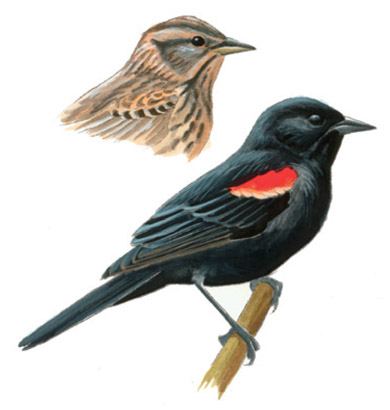
Family Icteridae (Blackbirds, Orioles, and Grackles)
Size: 8½"
Range: Throughout North America
Habitat: Marshes, meadows, agricultural areas near water
The Red-winged Blackbird is a widespread, ubiquitous, chunky meadow dweller that forms huge flocks during the nonbreeding season. The male is deep black overall, with bright orange-red lesser coverts and pale medial coverts that form an obvious shoulder patch in flight, but may be partially concealed on the perched bird. The female is barred in tan and dark brown overall, with pale superciliary stripes and a pale malar patch. The blackbirds forage marshlands for insects, spiders, and seeds. The voice is a loud, raspy, vibrating konk-a-leee given from a perch atop a tall reed or branch. The male (below) and female (above) are illustrated.
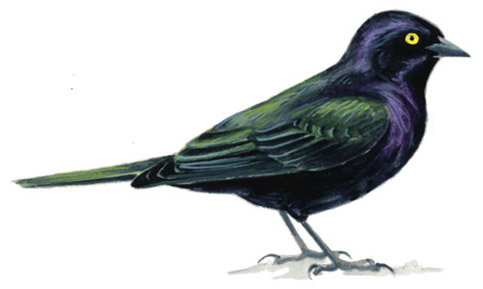
Family Icteridae (Blackbirds, Orioles, and Grackles)
Size: 9"
Range: Throughout the contiguous United States; most common farther west
Habitat: Meadows, pastures, open woodlands, urban areas
The Brewer’s Blackbird is small headed and dark, with a short bill and bright yellow eyes (in males). The breeding male is glossy black overall, with purple iridescence on the head and breast and green iridescence on the wings and tail. During winter the plumage is not as glossy. Females are drab brownish overall and usually have dark eyes. Brewer’s Blackbirds forage on the ground for seeds and insects, often while bowed over with their tails sticking up. The voice is a short, coarse zhet, and a longer, creaky trill. These blackbirds form large flocks in winter, along with other blackbird species. The breeding adult male is illustrated.
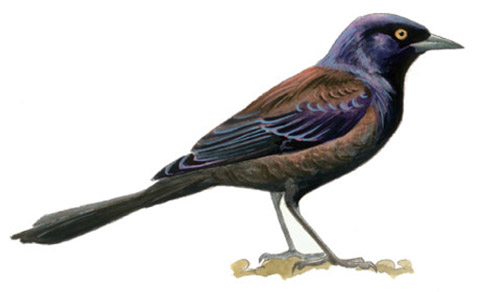
Family Icteridae (Blackbirds, Orioles, and Grackles)
Size: 12½"
Range: Eastern half of the United States
Habitat: Pastures, open woodlands, urban parks
The Common Grackle is a large blackbird with an elongate body; a long, heavy bill; and long tail, which is fatter toward the tip and is often folded into a keel shape. Plumage is overall black with a metallic sheen of purple on the head and brown on the wings and underside. The eyes are a contrasting light yellow color. Quite social, grackles form huge flocks with other blackbirds and forage on the ground for just about any kind of food, including insects, grains, refuse, and crustaceans. Their voice is a high-pitched, rasping trill. The illustration shows an adult male.
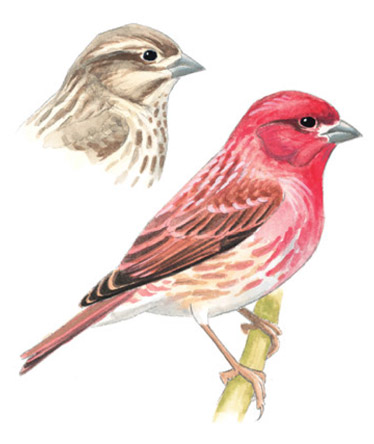
Family Fringillidae (Finches)
Size: 6"
Range: Eastern half of the United States; Pacific States
Habitat: Open coniferous and mixed woodlands, rural gardens and parks
The Purple Finch is a sturdy, large-headed finch with a short notched tail and a thick conical bill. The male is brownish red above with brown streaking and whitish below with dusky or pink streaking. The head and breast are not purple, but rosy red, and there is pale feathering at the base of the bill. Females and juveniles are brownish and heavily streaked, with noticeably darker facial markings on the crown, auricular, and malar regions. Purple Finches forage in small groups in trees or on the ground for seeds and insects. Their voice is a long, jumbled song of high whistles, cheeps, and trills. The adult female (top) and adult male are illustrated.
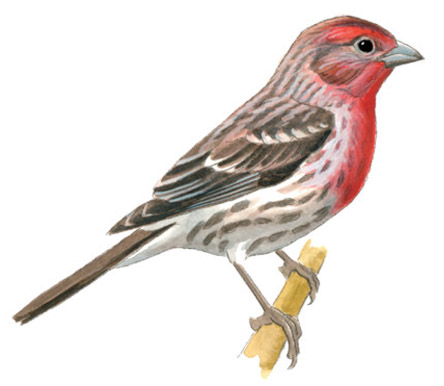
Family Fringillidae (Finches)
Size: 6"
Range: Throughout the contiguous United States
Habitat: Woodland edges, urban areas
The House Finch is a western species that was introduced to eastern North America and is now common and widespread across the country. It is a relatively slim finch, with a longish, slightly notched tail and a short conical bill with a downcurved culmen. The male is brown above with streaking on the back, while below it is pale with heavy streaking. An orange-red wash pervades the supercilium, throat, and upper breast. The female is a drab gray brown, with similar streaking on the back and underside and no red on the face or breast. House Finches have a variable diet that includes seeds, insects, and fruit, and they are often the most abundant birds at feeders. Their voice is a rapid musical warble. The adult male is illustrated.
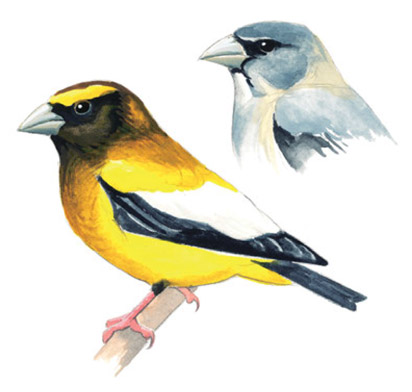
Family Fringillidae (Finches)
Size: 8"
Range: Northern and mountainous regions of the United States; Pacific Northwes
Habitat: Coniferous or mixed woodlands, rural gardens
The Evening Grosbeak is a comical-looking finch with a large head, short stubby tail, and enormous conical bill. In the male, plumage fades from dark brown on the head to bright yellow toward the rump and belly. His wings are black, with large white patches on the secondaries and tertials. The yellow superciliums merge with his flat forehead and meet his pale yellow-green bill. The legs are short and pinkish. Females are grayish overall, with choppy white markings on the wings. Evening Grosbeaks travel in flocks to feed on seeds and berries in the upper canopy and will often visit feeders, preferring sunflower seeds. Their voice is a series of short, spaced, rattling cheep notes. The male (bottom) and female (top) are illustrated.
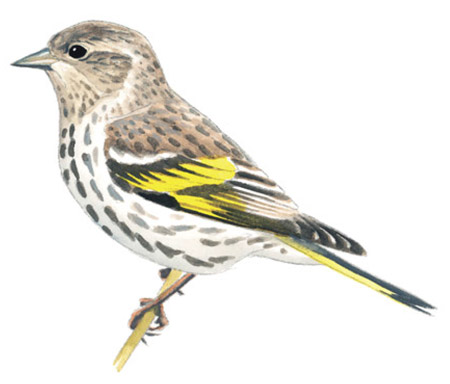
Family Fringillidae (Finches)
Size: 5"
Range: Throughout the contiguous United States; Alaska
Habitat: Coniferous woodlands, rural gardens
The Pine Siskin is a small, cryptically colored finch with a short tail and narrow, pointed bill. The male’s head and back are light brown overall, heavily streaked with darker brown. His underside is whit-ish and streaked in darker shades. There is a prominent yellow wing bar on the greater coverts and yellow on the flight feather edges and at the base of the primaries. Females are marked similarly, with a darker underside and white—not yellow—wing bars. Individuals can be quite variable as to the amount of streaking and the prominence of the yellow coloring. Pine Siskins forage energetically in small groups for seeds and insects, sometimes clinging upside down on twigs to reach food. Their voice consists of high-pitched, erratic, raspy chips and trills. The adult male is illustrated.
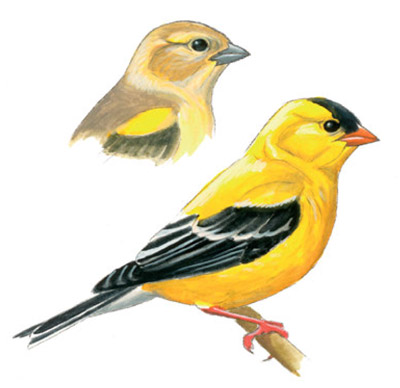
Family Fringillidae (Finches)
Size: 5"
Range: Throughout the contiguous United States
Habitat: Open fields, marshes, urban feeders
The American Goldfinch is a small, cheerful, social finch with a short, notched tail and a small conical bill. In winter it is brownish gray, lighter underneath, with black wings and tail. There are two white wing bars and bright yellow on the shoulders, around the eyes, and along the chin. In breeding plumage, the male becomes light yellow across the back, underside, and head; develops a black forehead and loral area; and the bill becomes orange. Females look similar to the winter males. American Goldfinches forage by actively searching for insects and seeds of all kinds, particularly thistle seeds. Their voice is a meandering, musical warble that includes high cheep notes. The breeding female (top) and breeding male (bottom) are illustrated.
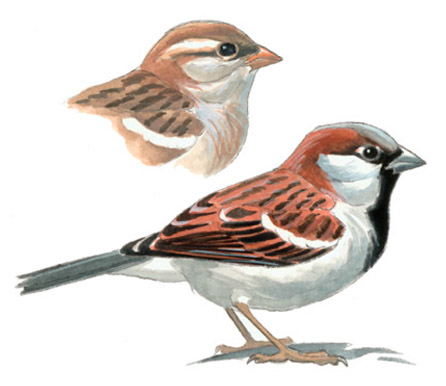
Family Passeridae (Old World Sparrows)
Size: 6¼"
Range: Throughout the contiguous United States
Habitat: Urban environments, rural pastures
Introduced from Europe, the House Sparrow is ubiquitous in almost every city in the United States and is often the only sparrow-type bird seen in urban areas. It is stocky, aggressive, and gregarious and has a relatively large head and a short finch-like bill. Males are streaked brown and black above and are pale below. The lores, chin, and breast are black, while the crown and auriculars are gray. There are prominent white wing bars at the median coverts. In winter the male lacks the dark breast patch. Females are drab overall, with a lighter bill and pale supercilium. House Sparrows have a highly varied diet, including grains, insects, berries, and crumbs from the local cafe. Their voice is a series of rather unmusical chirps. The breeding female (top) and breeding male (bottom) are illustrated.